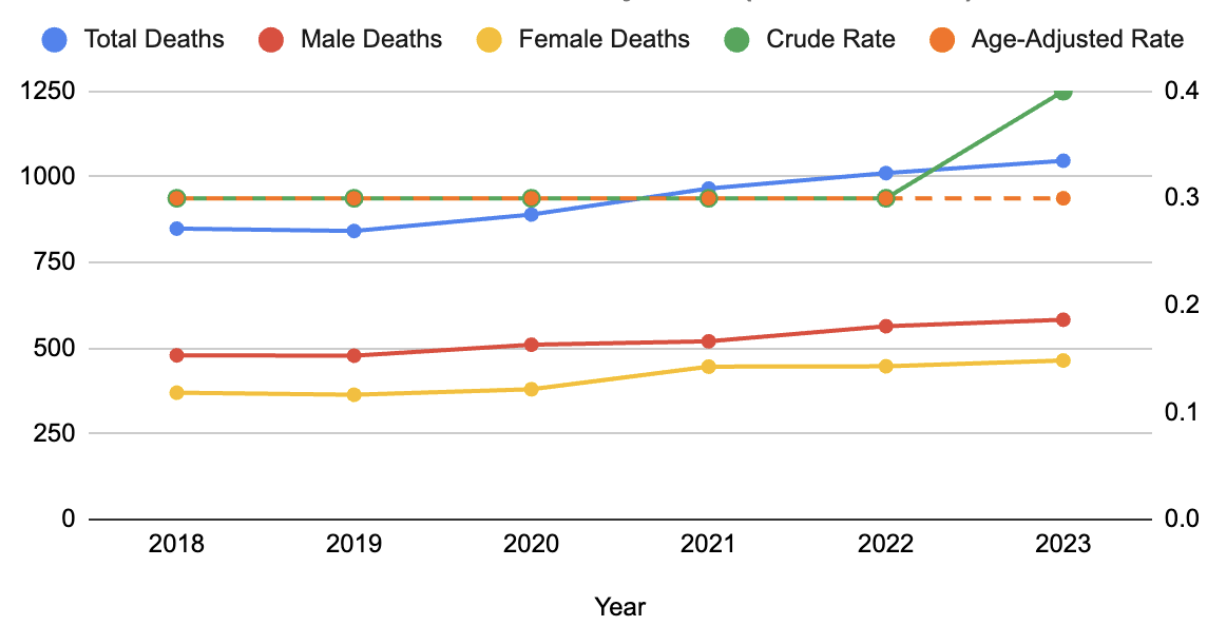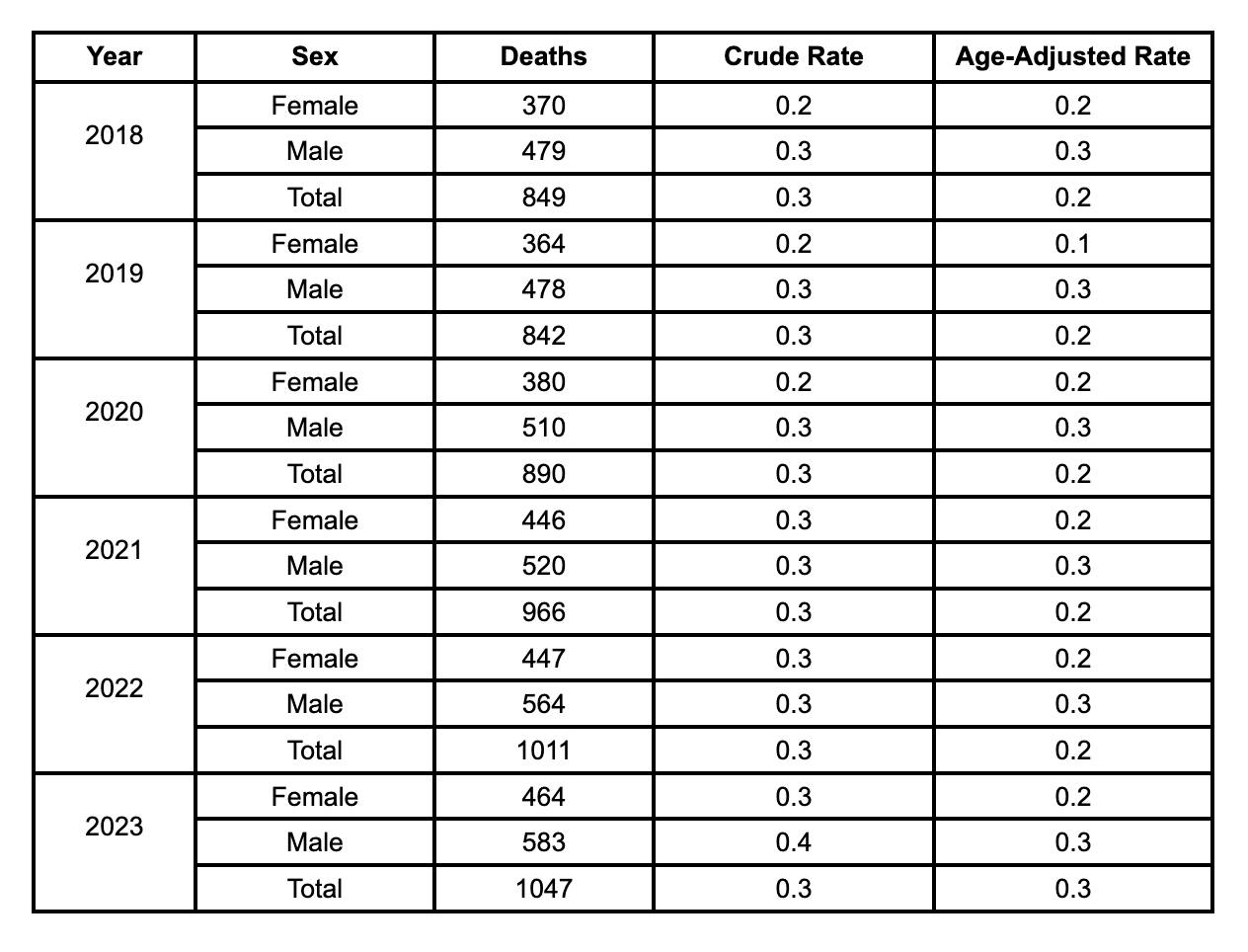Tuesday Poster Session
Category: GI Bleeding
P5202 - Trends in Mortality From Gastrointestinal Hemorrhage in Patients With Colorectal Cancer: Insights From CDC WONDER (2018–2023)
Tuesday, October 28, 2025
10:30 AM - 4:00 PM MT
Location: Exhibit Hall
- NS
Neha Singh, MD
NORTH ALABAMA MEDICAL CENTER
Florence, AL
Presenting Author(s)
Neha Singh, MD1, Jay Patel, MBBS2, Salma Abdelhafez, MBBCh3, Mariam Abdelhafez, 3, Ahmad Alhomaid, MD4, Sindhura Reddy Dadi, MBBS5, Utkarsh Dayal, MD6, Sri Anjali Gorle, 7, Rupak Desai, MBBS8
1NORTH ALABAMA MEDICAL CENTER, Florence, AL; 2B.J. Medical College, Ahmedabad, Gujarat, India; 3Ain Shams University, Cairo, Al Qahirah, Egypt; 4Nazareth Hospital, Philadelphia, PA; 5Mnr medical college and hospital, Sangareddy, Telangana, India; 6Saint Vincent Hospital, Worcester, MA; 7Andhra Medical College, Visakhapatnam, Andhra Pradesh, India; 8Independent Outcomes Researcher, Atlanta, GA
Introduction: Colorectal Cancer is the second leading cause of cancer-related deaths. GI Hemorrhage (GIH) is a significant complication of CRC that presents as a serious life-threatening emergency, which increases morbidity and mortality risk. Although GIH associated with CRC is clinically severe, the data on recent national mortality trends are insufficient. This study attempts to bridge the gap through recent nationwide mortality data in the United States, and it will be valuable in guiding treatment plans and public health priorities.
Methods: A retrospective analysis using data from the CDC WONDER database (2018-2023) for colorectal cancer deaths, which were identified using ICD-10 codes for colorectal cancer (C18.0-C20) and gastrointestinal hemorrhage (K92.2). Crude and age-adjusted death rates per 100000 were estimated for each year, and we examined trends over time using linear regression and also estimated average annual percent change (AAPC) by sex.
Results: A total of 5605 deaths were recorded between 2018 and 2023. The number of deaths increased, from 849 (370 in females, 479 in males) in 2018 to 1,047 (464 in females, 583 in males) in 2023. Over the years, the annual crude and age-adjusted mortality rates were stable at 0.3 deaths per 100,000 and 0.2 deaths per 100,000, respectively. The AAPC did not show any significant trend. For all years, males consistently had higher crude and age-adjusted mortality rates than females (Table 1).
Discussion: The increase in the number of deaths from GIH in CRC patients shows a rising healthcare cost and resource allocation. However, the crude and age-adjusted mortality rates of GIH associated with CRC patients remain stable; thus, the increase in deaths is not reflected by an increase in population-level risk. Future research should consider risk stratification by analyzing demographics and tumor characteristics, and the role of screening and bleeding risk reduction strategies in decreasing mortality rates.

Figure: Trends in Mortality from GI Hemorrhage in Colorectal Cancer: Deaths and Rates by Sex (2018-2023)

Figure: Table 1. Annual Total and Sex-Specific Deaths with Crude and Age-Adjusted Mortality Rates from Gastrointestinal Hemorrhage in Patients with Colorectal Cancer in the United States (2018–2023)
Disclosures:
Neha Singh indicated no relevant financial relationships.
Jay Patel indicated no relevant financial relationships.
Salma Abdelhafez indicated no relevant financial relationships.
Mariam Abdelhafez indicated no relevant financial relationships.
Ahmad Alhomaid indicated no relevant financial relationships.
Sindhura Reddy Dadi indicated no relevant financial relationships.
Utkarsh Dayal indicated no relevant financial relationships.
Sri Anjali Gorle indicated no relevant financial relationships.
Rupak Desai indicated no relevant financial relationships.
Neha Singh, MD1, Jay Patel, MBBS2, Salma Abdelhafez, MBBCh3, Mariam Abdelhafez, 3, Ahmad Alhomaid, MD4, Sindhura Reddy Dadi, MBBS5, Utkarsh Dayal, MD6, Sri Anjali Gorle, 7, Rupak Desai, MBBS8. P5202 - Trends in Mortality From Gastrointestinal Hemorrhage in Patients With Colorectal Cancer: Insights From CDC WONDER (2018–2023), ACG 2025 Annual Scientific Meeting Abstracts. Phoenix, AZ: American College of Gastroenterology.
1NORTH ALABAMA MEDICAL CENTER, Florence, AL; 2B.J. Medical College, Ahmedabad, Gujarat, India; 3Ain Shams University, Cairo, Al Qahirah, Egypt; 4Nazareth Hospital, Philadelphia, PA; 5Mnr medical college and hospital, Sangareddy, Telangana, India; 6Saint Vincent Hospital, Worcester, MA; 7Andhra Medical College, Visakhapatnam, Andhra Pradesh, India; 8Independent Outcomes Researcher, Atlanta, GA
Introduction: Colorectal Cancer is the second leading cause of cancer-related deaths. GI Hemorrhage (GIH) is a significant complication of CRC that presents as a serious life-threatening emergency, which increases morbidity and mortality risk. Although GIH associated with CRC is clinically severe, the data on recent national mortality trends are insufficient. This study attempts to bridge the gap through recent nationwide mortality data in the United States, and it will be valuable in guiding treatment plans and public health priorities.
Methods: A retrospective analysis using data from the CDC WONDER database (2018-2023) for colorectal cancer deaths, which were identified using ICD-10 codes for colorectal cancer (C18.0-C20) and gastrointestinal hemorrhage (K92.2). Crude and age-adjusted death rates per 100000 were estimated for each year, and we examined trends over time using linear regression and also estimated average annual percent change (AAPC) by sex.
Results: A total of 5605 deaths were recorded between 2018 and 2023. The number of deaths increased, from 849 (370 in females, 479 in males) in 2018 to 1,047 (464 in females, 583 in males) in 2023. Over the years, the annual crude and age-adjusted mortality rates were stable at 0.3 deaths per 100,000 and 0.2 deaths per 100,000, respectively. The AAPC did not show any significant trend. For all years, males consistently had higher crude and age-adjusted mortality rates than females (Table 1).
Discussion: The increase in the number of deaths from GIH in CRC patients shows a rising healthcare cost and resource allocation. However, the crude and age-adjusted mortality rates of GIH associated with CRC patients remain stable; thus, the increase in deaths is not reflected by an increase in population-level risk. Future research should consider risk stratification by analyzing demographics and tumor characteristics, and the role of screening and bleeding risk reduction strategies in decreasing mortality rates.

Figure: Trends in Mortality from GI Hemorrhage in Colorectal Cancer: Deaths and Rates by Sex (2018-2023)

Figure: Table 1. Annual Total and Sex-Specific Deaths with Crude and Age-Adjusted Mortality Rates from Gastrointestinal Hemorrhage in Patients with Colorectal Cancer in the United States (2018–2023)
Disclosures:
Neha Singh indicated no relevant financial relationships.
Jay Patel indicated no relevant financial relationships.
Salma Abdelhafez indicated no relevant financial relationships.
Mariam Abdelhafez indicated no relevant financial relationships.
Ahmad Alhomaid indicated no relevant financial relationships.
Sindhura Reddy Dadi indicated no relevant financial relationships.
Utkarsh Dayal indicated no relevant financial relationships.
Sri Anjali Gorle indicated no relevant financial relationships.
Rupak Desai indicated no relevant financial relationships.
Neha Singh, MD1, Jay Patel, MBBS2, Salma Abdelhafez, MBBCh3, Mariam Abdelhafez, 3, Ahmad Alhomaid, MD4, Sindhura Reddy Dadi, MBBS5, Utkarsh Dayal, MD6, Sri Anjali Gorle, 7, Rupak Desai, MBBS8. P5202 - Trends in Mortality From Gastrointestinal Hemorrhage in Patients With Colorectal Cancer: Insights From CDC WONDER (2018–2023), ACG 2025 Annual Scientific Meeting Abstracts. Phoenix, AZ: American College of Gastroenterology.
